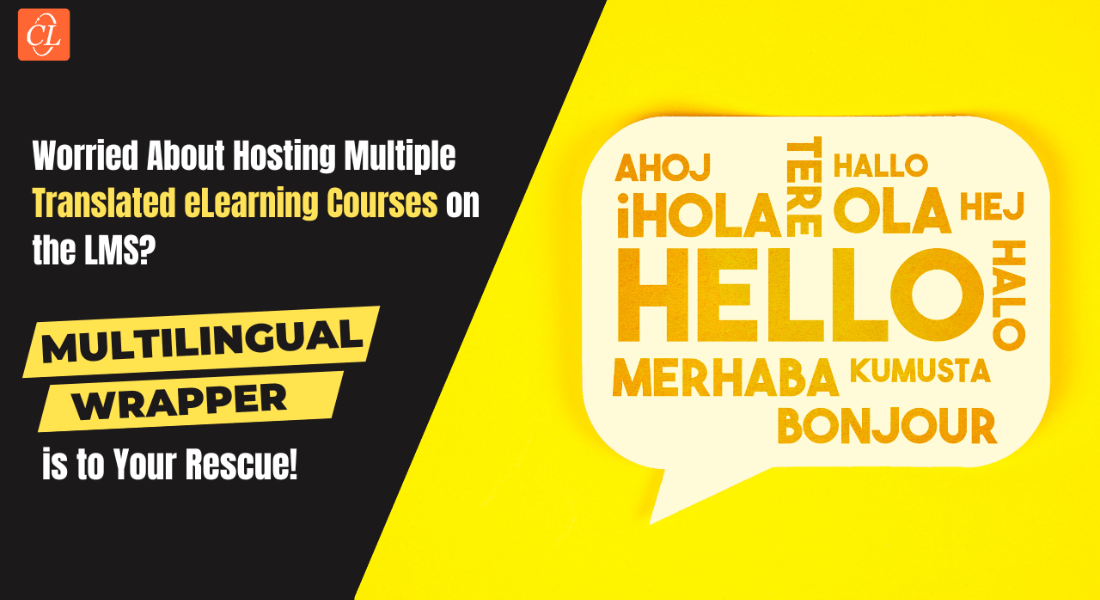How Multilingual Wrapper Can Streamline Hosting Translated eLearning Courses in Your LMS

Companies in today’s corporate era have their workforce spread globally, and the language barrier makes it quite challenging to train them all. Hence, L&D professionals prefer the training courses to be translated into multiple regional languages, to keep the employees engaged and retain the information they gain. eLearning translations with the help of advanced technology and experts have made it possible for organizations to cater quality training to their global workforce. However, the database and storage aspect is still a hassle, because if you are translating a course into 25 languages, your LMS has to store and host 25 separate copies of the course. Does this sound like a problem? If yes, we have a solution called “Multilingual Wrapper”.
Wondering How Various Aspects of An LMS Are Made Easy With a “Multilingual Wrapper”?
These 5 Aspects of an LMS are streamlined with a “Multilingual Wrapper”:
- LMS Admin Tasks
- Asset Storage
- Course Updates
- Course Reports
- User Experience
Check out the versatility of a “Multilingual Wrapper” below.
Before we talk about the multilingual wrapper in detail, let’s understand the most common limitations of a generic LMS, that lead us to the development of this specific solution.
Common LMS Limitations While Hosting Translated eLearning Courses
1. Uploading multiple SCORM packages
When you are translating your eLearning course, an LMS requires all the copies in distinct languages or all the SCORM packages to be uploaded. So, when an eLearning course is translated into 10 languages, it will have 10 versions, 1 of each language uploaded separately in the LMS.
2. Managing multiple source files
As discussed in the previous point, you have to upload multiple copies, and hence, you have to store and manage each one of them separately as well. This can be chaotic when a course has to be delivered in a lot of languages.
3. Replacing updated versions
The eLearning courses often need updates because of the forever-changing dynamics of corporate training. To keep up with the latest trends and technologies, changes are made in the eLearning courses frequently, and it becomes challenging when there are so many files to be updated in the LMS, in different languages, of the same course.
4. Generating a consolidated report
When the eLearning courses are delivered to the global workforce, their performance report has to be generated. LMS generally have the feature to generate reports, but the reports are generated for all languages, and to receive a collective report of the course in multiple languages, becomes problematic.
5. Switching languages
If the learners are mid-way into the course, and they wished to change the language, they couldn’t. Learners have to go through the starting enrollment process again and change the language to access the course in the desired language.
A Multilingual wrapper has the capability to mitigate these problems and streamline the storing and hosting of eLearning courses translated into multiple languages in your LMS. But, what exactly is a multilingual wrapper? Let’s find out.
What’s A Multilingual Wrapper?
A Multilingual Wrapper is a software tool that merges all the translated versions of an eLearning course into one big single file for the learners. Combining all the translated copies of the course in one file makes it easy for the learners to navigate through the course in different languages without juggling versions from scratch every time a new language is selected. The best part is, you don’t need to be a programmer/coder to use the software, it’s pretty much automated in those terms.
5 Major Aspects of LMS: Made Easy with A Multilingual Wrapper
1. LMS Admin Tasks
The Wrapper merges all the versions and makes the whole course that’s translated into multiple languages, as a single SCORM package. This enables the course to be hosted and administered just once, and thus the LMS admin doesn’t need to manage every version with different languages, instead, just one course.
2. Asset Storage
Since the wrapper combines all the versions of the course, you don’t have to manage the source files for each language either. You can place all the files in the shell, and you can now locate the source files easily in the archives section.
3. Course Updates
When you want to update the course or only some versions, you don’t have to do it separately, instead, all you have to do is remove the existing course shell and upload the new shell just once, and the course will be updated for you.
4. Course Reports
With a multilingual wrapper, you host just one eLearning course, and due to that, you can easily generate the collective report of that course. This saves a lot of time and effort that would have been wasted generating reports separately for all the languages one by one.
5. User Experience
Learners can switch languages mid-course and switch back to the old one again, without going back to the start of the course and enrolling themselves again from scratch.
Wrapping Up!
A multilingual wrapper is indeed an impactful tool to ease out your LMS issues and help organizations cater the eLearning courses effectively to their global workforce. When the courses are delivered without problems, learners stay engaged in the course, which eventually enhances the training ROI for the companies. Get started with the amazing “Multilingual Wrapper” for yourself and eliminate all your LMS challenges.





